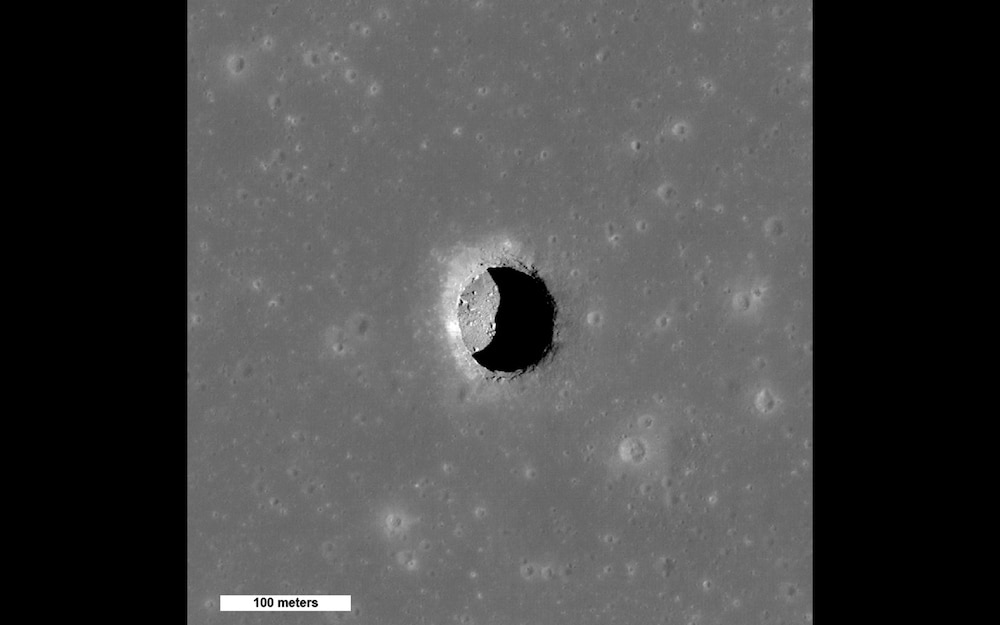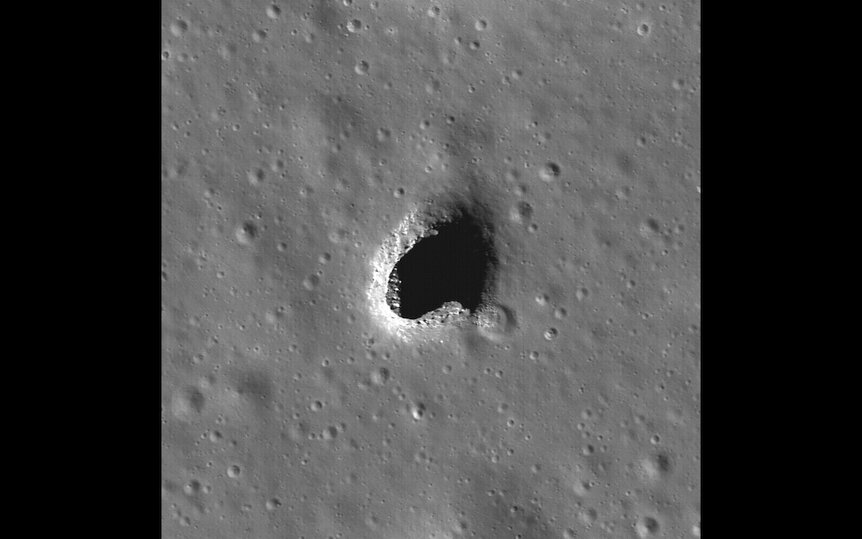Create a free profile to get unlimited access to exclusive videos, sweepstakes, and more!
Wanna live on the Moon? Pack a sweater and a spacesuit and move to a lava tube.
Temperatures inside underground lunar caves may be stable around 63°F.

If and when humans establish a permanent base on the Moon, it’ll be the pits.
Collapse pits, I should add. These are holes in the lunar surface where the roofs of cave-like lava tube have collapsed, allowing relatively easy access to underground “rooms” which can provide a pre-fab haven for astronauts working and living on the Moon.
This idea has been around for a long time, but new research just published shows that these caves can maintain fairly mild temperatures, protected from the savage heat of sunlight during the lunar day and the brutal chill of lunar night [link to paper].
The basic geology here is that long ago, billions of years in the past, the Moon was pretty active volcanically. Flowing lava would carve channels into the surface — we see many of these long grooves on the Moon called rilles — and sometimes in recurrent eruptions the lava will solidify on top, creating a tube. When the lava continues on, this leaves behind a roughly cylindrical hollow underground chamber, a cave shaped like a long macaroni, called a lava tube.
These could be completely hidden from the surface, but sometimes a small section of the roof can collapse, either through seismic activity or a nearby asteroid impact shaking the ground. We see this as an open pit in the surface, with the floor of the tube below it.
Sixteen such collapsed pits over lunar lava tubes are known; the first was discovered by the Japanese SELENE mission in 2009. Most are in the lunar maria, the dark regions you can see by eye that are lava-flooded plains, and all are in areas known to have once been volcanic.
Once known, engineers and scientists became interested in possibly using them as bases for lunar exploration. Assuming the roof is steady enough — probably true; big moonquakes are rare — they have several advantages to living on the surface. For one they protect against the harmful solar radiation, including ultraviolet light and fast subatomic particles making up the solar wind; they protect against small micrometeoroid impacts that can put a hole in a habitation module; and they may have thermal properties that prevent huge temperature swings suffered by the exposed lunar surface.
That last is what was investigated in the new work. The lunar day/night cycle is an Earth-month long, with the Sun up for two weeks followed by two weeks of night. The temperature swings can be huge, going from -180°C (-300°F) at night to well over 120°C (260°F) during the day, depending on location and local topography. Insulating a base on the surface from that can be difficult, but lava tubes provide a natural insulation.
The scientists doing the study used observations of a roughly 100-meter-wide pit in Mare Tranquillitatis that’s just a few hundred kilometers northeast of where Apollo11 landed. The measurements were made by the Diviner Lunar Radiometer Experiment aboard the Lunar Reconnaissance Orbiter, which has been orbiting the Moon since 2009. Diviner is sensitive to a wide range of the electromagnetic spectrum, including the kind of thermal infrared light emitted by warm objects. Its observations can be used to measure the temperature of locations on the lunar surface.
Using measurements taken at many different times of the lunar day and night, the scientists created physics-based models of what the temperature would be like inside the lava tube under a lot of different assumptions, including the size and extent of the tube, what the floor is made of — hard rock versus the more fluffy lunar regolith, which has a consistency like volcanic ash — and included the angle of sunlight given the pit’s location not far from the lunar equator.
Their models indicate that in some places, like on the floor in direct sunlight under the pit opening, it gets hot during the day, about 150°C (300°F). That would be the hottest known temperature on the Moon, so that’s not a great spot. But that patch of heated surface then indirectly illuminates and warms up the rest of the cave. The rock walls are excellent thermal insulators, and overall they found that in general the temperature inside the lava tube stays around 17°C (63°F), which is maybe a lit bit on the chilly side but far better than literally boiling you out of your skin or freezing you into a solid block of ice at night. Sweater weather, assuming you want to wear one under your spacesuit.
There are temperature variations depending on the specific conditions, but overall and generally speaking lunar lava tubes may be the place to be for future bases. You’d still need to build airtight modules, but living there would be a lot easier than on the surface*. The European Space Agency thinks so; in 2019 they put out a call for ideas on how to explore lava tubes. It would involve some technology and engineering that hasn’t been fully explored yet, like a crane that could lower heavy material down to the cave floor. It would also be nice to test the strength and structure of the roof.
It maybe doesn’t have the glamour of a large base on the surface, but living in a lave tube has a lot of built-in advantages, and habitat construction might be simplified in the long run.
When it comes to living on the Moon, we have to be clever. It won’t be easy, and it won’t be cheap, so we have to use what materials we find in situ, including taking advantage of the local geology.




























